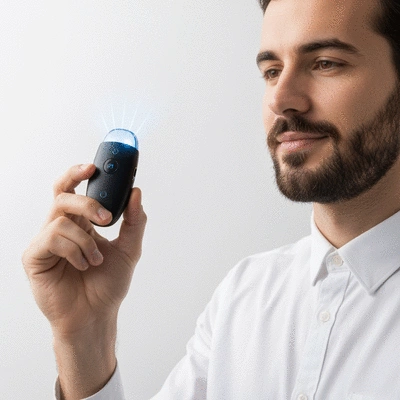Mechanisms of Action
- ➤ Electrical Stimulation: Modulates nerve activity with currents.
- ➤ Magnetic Stimulation: Impacts brain function using magnetic fields.
- ➤ Temperature-Based: Affects nerve signals through temperature changes.
For many migraine sufferers, finding effective relief can feel like a daunting challenge. Understanding how innovative migraine neuromodulation devices can help you manage your condition is crucial. These devices offer a non-invasive alternative to traditional medications, opening new doors for effective treatment.
A visual overview of how these innovative devices work and the key FDA-cleared options available.
Have you ever wished for a way to manage your migraines without relying heavily on medications? Migraine neuromodulation devices may offer a promising alternative for many. These innovative tools aim to alter nerve activity in the brain, potentially reducing the frequency and intensity of migraine attacks. Let’s dive into what these devices are and how they work!
Migraine neuromodulation devices are specially designed tools that use various techniques to influence nerve activity in the brain. The goal here is straightforward: to reduce pain and other symptoms associated with migraines. Understanding neuromodulation is crucial, as it involves modifying the way neurons communicate, which can lead to significant improvements in migraine management.
Neuromodulation refers to the process of altering nerve activity through targeted stimulation. In migraine treatment, this can involve techniques that either stimulate specific areas of the brain or inhibit pain pathways. By doing so, it aims to provide relief for those suffering from chronic headaches. This treatment option is particularly appealing for individuals who prefer non-pharmaceutical interventions!
Each of these techniques has its own unique benefits and mechanisms, allowing for personalized treatment plans that cater to individual needs. By understanding these options, migraine sufferers can better navigate their treatment journeys.
Curious about how these devices actually operate? Understanding the science behind them can empower you to make informed decisions about your migraine management. Let's delve into the various mechanisms at play!
Electrical and magnetic stimulation techniques work by sending signals to the brain that can change how it processes pain. Devices like transcutaneous electrical nerve stimulation (TENS) and transcranial magnetic stimulation (TMS) fall into this category. By using gentle electrical impulses or magnets, they can prompt the brain to release natural pain-relieving chemicals, thereby reducing the sensation of pain.
Temperature-based stimulation is another fascinating area that can aid in migraine relief. By applying heat or cold to specific areas, these devices can influence nerve activity. Cold therapy, for instance, may help numb pain and reduce inflammation, while heat can increase blood flow and promote relaxation.
Transcranial Magnetic Stimulation (TMS) is an exciting and innovative approach to migraine treatment. This non-invasive procedure uses magnetic fields to stimulate nerve cells in the brain. Research has suggested that TMS may not only help alleviate migraine pain but can also reduce the frequency of attacks. If you’re interested in exploring this option, I encourage you to discuss it with your healthcare provider!
With various neuromodulation devices available today, it can be challenging to know which one might suit you best. Here’s a look at some of the most prominent FDA-cleared options:
Cefaly is a well-known device that uses electrical stimulation to target the trigeminal nerve, which plays a vital role in headache disorders. Users wear a small, adhesive electrode on their foreheads, and the device delivers gentle pulses that can help reduce migraine frequency.
Nerivio is a wearable device that utilizes electrical stimulation through the skin on the upper arm. It’s controlled via a smartphone app, allowing for personalized treatment sessions. Many users find it convenient and effective for managing acute migraine attacks.
Relivion MG offers a multi-modal approach by combining electrical, magnetic, and temperature-based stimulation. This versatility makes it an attractive option for those seeking comprehensive migraine relief. Plus, its portable design makes it easy to use anytime, anywhere!
Emerging bioelectronic devices represent a new frontier in migraine treatment. These devices aim to interact with the nervous system to modulate pain signals. While still in the developmental stages, they hold great promise for the future of migraine management.
Not everyone will respond to neuromodulation devices the same way, but many individuals can find relief through these innovative solutions. Let's explore who might benefit the most from these treatments!
For those who prefer not to rely solely on medications, neuromodulation devices can be a game-changer. They provide a non-pharmacological approach to migraine management, which can be particularly appealing to those who experience medication-related side effects.
Pregnant women or those with heightened sensitivity to medications may also find these devices beneficial. As always, it’s essential to consult with a healthcare professional to ensure safety and efficacy.
Identifying the right candidates for neuromodulation therapy is crucial for achieving the best outcomes. By working closely with a healthcare provider, patients can explore whether these devices might be a suitable fit for their needs.
Chronic migraine sufferers may benefit more from ongoing neuromodulation therapy, while individuals dealing with occasional acute attacks could find intermittent use particularly effective. Understanding your migraine pattern can help guide your treatment choices!
As with any treatment, safety and side effects are essential considerations. Let’s take a closer look at what you should know about neuromodulation devices.
Most neuromodulation devices have minimal side effects, with some users experiencing mild discomfort or skin irritation at the application site. It’s crucial to monitor your body’s response when trying a new device to ensure it aligns with your needs.
Some neuromodulation devices are available over-the-counter, while others require a prescription. Typically, prescription devices undergo more rigorous testing, which may provide additional peace of mind when considering your options.
All FDA-cleared devices have undergone thorough evaluation to ensure their safety and effectiveness. This regulatory oversight provides a level of assurance for patients looking to incorporate these tools into their migraine management plan.
Understanding the long-term efficacy of neuromodulation devices is crucial for those considering their use. As always, I recommend looking at current research and patient testimonials to gather insights!
Recent studies have shown promising results regarding the efficacy of various neuromodulation devices in reducing the severity and frequency of migraines. As research continues to evolve, it’s exciting to see how these devices can improve the quality of life for many.
Many patients have shared their success stories with these devices, praising their convenience and effectiveness. Hearing firsthand experiences can provide valuable context as you weigh your treatment options.
Numerous studies highlight significant improvements in quality of life for users of neuromodulation devices. If you’re considering this approach, it’s worth exploring how it could positively impact your daily life, too!
Understanding the cost and accessibility of neuromodulation devices is a key factor in making informed decisions. Let’s break down what you need to know!
The cost of neuromodulation devices varies widely, depending on the type and features. It’s essential to explore available payment options and whether your healthcare provider offers any financial assistance programs.
Insurance coverage for these devices can be inconsistent. Check with your insurance provider to see if these treatments may be covered under your plan. This step can significantly affect your overall cost!
When considering cost, evaluating the long-term savings from reduced medication use and fewer migraine days can be incredibly beneficial. Many patients find that the initial investment in a device pays off over time.
Choosing the right device can feel overwhelming, but it doesn’t have to be! Here are some practical tips to guide your decision-making process.
Start by assessing your personal needs and what you hope to achieve with neuromodulation therapy. Are you looking for acute relief, or are you hoping to manage chronic migraines? Having clear treatment goals will steer you toward the best options.
Don’t hesitate to reach out to your healthcare provider for recommendations. They can help you understand which devices are best suited for your specific circumstances and provide valuable insights tailored to your situation!
Having an open dialogue with your headache specialist can significantly enhance your treatment journey. Remember, you’re not alone in this process; we at Migraines Unraveled are here to support you every step of the way!
Have you tried any neuromodulation devices for your migraines? We’d love to hear about your experiences! Please share your thoughts below:
As we navigate the complex landscape of migraine management, it's crucial to highlight the advantages of neuromodulation devices. These innovative tools offer migraine sufferers a new avenue for relief, often without the side effects associated with traditional medications. Embracing these technologies can empower you to take control of your health and improve your quality of life.
Let's take a closer look at some of the key benefits that neuromodulation devices offer for migraine relief. Understanding these points can help you make informed choices about your treatment options.
Neuromodulation devices represent a shift towards non-invasive interventions in migraine treatment. Here are a few critical takeaways:
It's important to consider who might benefit most from these treatments. If you're someone who has struggled with chronic migraines or if medications haven’t worked for you, exploring these devices could be worthwhile.
Neuromodulation devices can be particularly beneficial for individuals in various circumstances. You may want to consider these options if you:
Identifying whether neuromodulation therapy is right for you can be a pivotal step in your migraine journey.
To maximize the benefits of any treatment, including neuromodulation devices, it's essential to understand your unique migraine triggers. These can include stress, dietary factors, or environmental changes. By keeping a migraine diary and noting the circumstances surrounding your attacks, you can provide valuable information to your healthcare provider.
Identifying your triggers not only helps in managing your migraines but also assists in selecting the most effective treatment options. An informed perspective can lead to better outcomes and a more positive management experience.
As you explore new avenues for migraine relief, it's vital to be proactive in your healthcare decisions. This means engaging in conversations with your healthcare provider about the latest treatment options available, including neuromodulation devices.
Remember, knowledge is power! Staying informed can help you navigate the complexities of your condition. Here are some steps to encourage informed decisions:
Always consult with your healthcare provider before making changes to your treatment plan. They can offer personalized insights tailored to your specific needs and circumstances. By discussing your interests in neuromodulation devices, you can collaboratively determine the best strategies for your situation.
The field of migraine treatment is constantly evolving. Keeping abreast of the latest research and device innovations can empower you. For more detailed insights into non-invasive neuromodulation devices for headache treatment, you can refer to resources like Practical Neurology.
Familiarizing yourself with clinical guidelines on migraine treatment can enhance your understanding of the available options. Look for resources that outline evidence-based practices for management, which can help you have more fruitful discussions with your healthcare team.
In conclusion, neuromodulation devices offer a promising alternative for those struggling with migraines. By understanding their benefits and how they can fit into your overall treatment plan, you’re taking an important step towards regaining control over your health. It's all about empowerment—let’s tackle those migraines together!
Here is a quick recap of the important points discussed in the article:



 Consider how a simple change in weather can turn your day upside down—especially for those who suf
Consider how a simple change in weather can turn your day upside down—especially for those who suf
 For many migraine sufferers, finding effective relief can feel like a daunting challenge. Understand
For many migraine sufferers, finding effective relief can feel like a daunting challenge. Understand
 To truly take control of your migraines, understanding the differences between medication options is
To truly take control of your migraines, understanding the differences between medication options is
 As we look toward 2025, the evolution of acute migraine treatments is a promising journey filled wit
As we look toward 2025, the evolution of acute migraine treatments is a promising journey filled wit